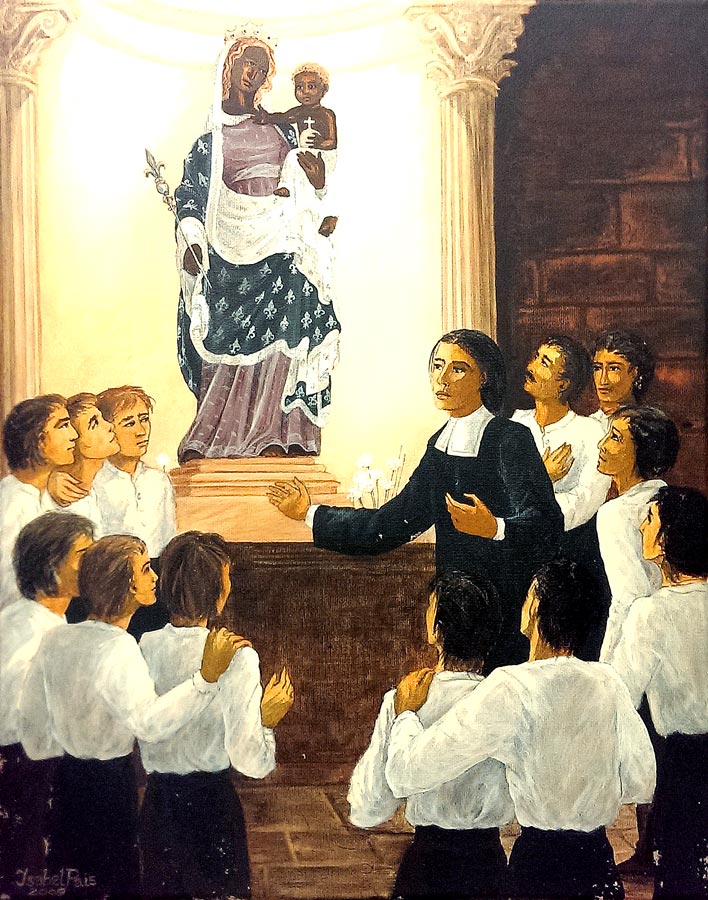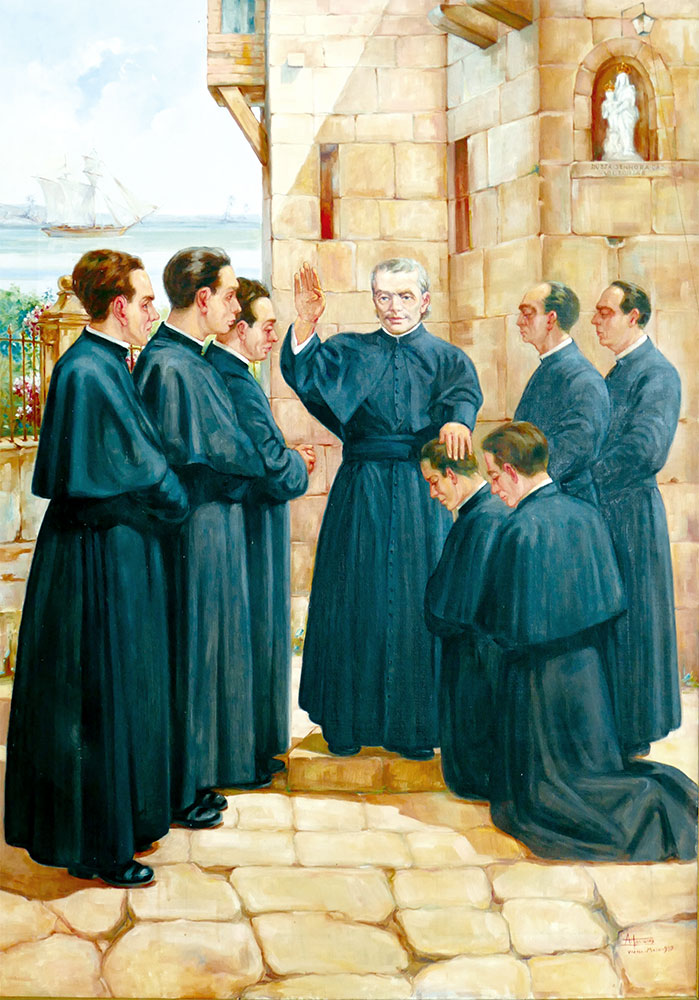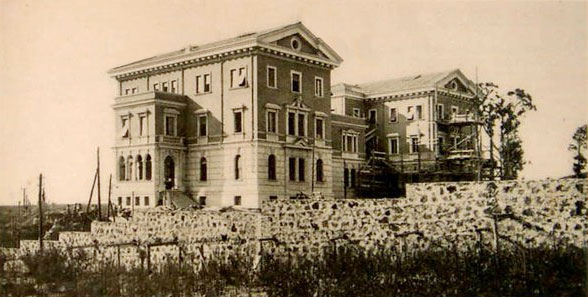| 1703 | On May 27th, the Feast of Pentecost, in the church of Saint-Etiènne-des-Grès in Paris, Claude Poullart des Places and his 12 companions consecrated themselves to the Holy Spirit, under the protection of the Blessed Virgin Mary, for their service to the poor. |
|---|---|
| 1707 | On December 17th, Claude Poullart des Places was ordained priest, aged 28. |
| 1709 | Claude Poullart des Places died on October 2nd aged 30. The following day, he was buried in a common grave for poor clerics at Saint-Etienne-du-Mont. By that time, there were 72 students in the Seminary of the Holy Spirit. They were the first “Spiritans” in the wide sense to emerge from the Seminary of the Holy Spirit. |
| 1732 | Spiritans started work in other continents: Fr. François Frison de la Mothe was sent to Quebec in Canada; others went to North America to the Amerindians and the Acadians, while some went to the Far East to work under the auspices of the Foreign Missions of Paris: China, Cambodia, Vietnam, Siam (Thailand) and India. Those remaining in France served in various dioceses or alongside the de Montfort missionaries, a result of the close friendship between Claude Poullart and St. Grignion de Montfort. |
| 1734 | The Archbishop of Paris, Mgr. de Vintmille, approved the Rules and Constitutions of the Seminary of the Community of the Holy Spirit and the Immaculate Conception (1726) and of the Immaculate Virgin (1734). |
| 1765- 1778 | In 1765, Rome confided to the Congregation of the Holy Spirit the Apostolic Prefectures of Saint-Pierre and Miquelon (1765), Guyane (1765) and Saint-Louis of Sénégal (1778). From 1766, the Community of the Holy Spirit used the title of “The Congregation of the Holy Spirit”. |
| 1791 | Up until this year, 22 Spiritans had worked in Saint-Pierre and Miquelon and in Acadia (Canada) as missionaries to the Indians and professors in the seminary of Quebec. But now the English colonisers were growing in strength and the Spiritans, being all from France, were expelled from Canada. But they continued their apostolate in the islands of Saint-Pierre and Miquelon. |
| 1792 | At the time of the French Revolution, all religious orders and congregations were suppressed. Some Spiritans sought refuge in England, Switzerland, and Italy while others worked for various dioceses in France until, thanks to the faith and courage of Fr. Jacques Bertout (1753-1832) who initially laboured as a priest in northern England, the work of the Spiritans was taken up once again. |
1703 – 1792
Foundation of the Congregation and the early developments up to the French Revolution
1805 - 1848
From the Restoration of the Congregation, until the “fusion”with the Society of the Holy Heart of Mary (Libermann)
| 1805 | The Congregation of the Holy Spirit was re-established by Napoleon on March 23rd, 1805 but suppressed a second time in 1809. |
|---|---|
| 1815 | The Congregation was re-established by King Louis XVIII, but it was not until 1822 that Fr. Bertout was able to recuperate the spiritan property in the rue des Postes. |
| 1824 | Rome approved the “Rules” of the Congregation of the Holy Spirit; from that time onwards, it was to depend directly on the Holy See. |
| 1839 | Following his experience of “a few small lights” that he received on October 28th at Rennes on the feast of Saints Simon and Jude, Libermann decided to take up the Work for the Black People. In early January, 1840, he travelled to Rome to advance the project. |
| 1841 | On December 25th, Francis Libermann, a convert Jew, assisted by Frs. Frédéric Le Vavasseur, Eugène Tisserant and the Abbé Desgenettes (who had persuaded him to pursue the Work for the Black People), presided at the foundation of the Society of the Holy Heart of Mary at a Mass in the church of Notre Dame des Victoires in Paris. The primary objective of this foundation was the evangelisation of the Black People in the French colonies and the struggle against the exploitation to which they were subjected after their emancipation from slavery. They would tell them of the “good news” of their God-given dignity . The first members soon set out on their mission appointments: Fr. Jacques Laval to Mauritius in 1841, Fr. Frédéric Le Vavasseur to Reunion in early 1842 and Fr. Eugène Tisserant to Haiti at the end of the same year. |
| 1842 | The Apostolic Vicariate of the two Guineas was set up. It comprised all the territory between Sénégal and the river Orange in southern Africa, apart from those areas already under the jurisdiction of the Bishop of Angola and Congo. Mgr. Edward Barron, originally from Ireland, the Vicar General of the diocese of Philadelphia, USA, was appointed the first Vicar Apostolic. Libermann decided to offer some members of the new Society of the Holy Heart of Mary to Mgr. Edward Barron for the evangelisation of the African continent. This was the beginning of the huge number of spiritan missionaries who would be sent to spread the Good News in Africa. |
| 1843- 1844 | 5 members of the first missionary group died in Africa or on the high seas. |
| 1844 | Fr. Bessieux and Brother Grégoire arrived in Gabon. |
| 1845 | Opening of the mission of Dakar. |
| 1846 | Mgr. Edward Barron resigned. The Apostolic Vicariate of the Two Guineas was confided to the Society of the Missionaries of the Holy Heart of Mary. |
| 1848 | The merger of the Society of the Holy Heart of Mary with the Congregation of the Holy Spirit. For the good of the mission, Libermann accepted the decision of the Congregation for the Propagation of the Faith, ratified by Pius IX on September 10th. The exact wording was : “… the union of the Society of the Missionaries of the Holy Heart of Mary with the Congregation of the Holy Spirit, in such a way that the former would cease to exist and its associates and aspirants would be aggregated into the Congregation of the Holy Spirit”. On November 3rd, the Congregation of the Propagation of the Faith agreed that the words “under the protection of the Immaculate Heart of the Blessed Virgin Mary” shouldbe added to the title of the Congregation of the Holy Spirit. On the same day, it approved the election of Francis Libermann as the 11th Superior General of the Congregation, replacing Fr. Monnet who was appointed Vicar Apostolic of Madagascar. |
1848 – 1965
Expanding Internationally: The Missionary Work of the Congregation, especially in Africa.
The Congregation of the Holy Spirit became a flourishing missionary family during the course of the 19th century, reinvigorated by the entry of the former members of Libermann’s society. It numbered 1,400 members in 1908. Several new Provinces were founded in Europe and North America while new areas of apostolate were opened up in Africa, South America, the Caribbean, the Indian Ocean, Asia and Australia.
| 1852 | Libermann died on February 2nd at the age of 50. Fr. Schwindenhammer was appointed Vicar General of the Congregation then formally elected Superior General the following year. |
|---|---|
| 1853 | First general assembly in the form of a Chapter at Notre Dame du Gard with 28 members. The Rules of 1849 were approved and a decision was taken to produce new rules which would reflect the practices of religious life, community life, a distinctive habit and further details of interior organisation. |
| 1859 | The first Spiritan presence in Ireland: the Congregation opened a junior scholasticate at Blanchardstown. The following year, the community was transferred to Blackrock where a school was started. The ordination of the first two Irish Spiritans took place in 1866. |
| 1862 | The spiritan penetration of East Africa began. They arrived on the island of Zanzibar and six years later moved to the town of Bagamoyo on the African continent. |
| 1863 | The creation of the Province of Germany. Ten years later, the Spiritans were expelled from the country and were readmitted in 1895. |
| 1865 | Rome confided the Prefecture of Portuguese Congo (Angola) to the Spiritans, which had been abandoned by the Capuchins in 1836. Fr. Schwindenhammer retained the title of Prefect Apostolic and appointed Fr. Poussot as Vice-Prefect. But it was Fr. Duparquet who became the great builder of the spiritan presence, not just in this region of Africa, but also in Portugal from 1867 onwards. |
| 1868 | The first Dutchman to enter the Congregation was Brother Pius Orbons. With the German Spiritans, he later left for the United States to start a new Province, but shortly afterwards, he returned to his own country to set up the Congregation there. |
| 1872 | From this date, the Spiritans returned to North America, Canada and the United States, to care for minorities, immigrants and different ethnic groups. |
| 1877 | The first mission in Guinea (Boffa). |
| 1881 | Fr. Le Vavasseur was elected Superior General. |
| 1882 | Fr. Emonet was elected Superior General. |
| 1883 | Mgr Carrie, the Vicar Apostolic of Congo (Loango) sent Fr. Augouard to set up the first mission in the interior (Linzolo). |
| 1885 | The first Spiritans arrived in Nigeria (Fr. Lutz). They proceeded up the Niger and settled at Onitsha. |
| 1887 | Mgr. Carrie created the mission of Brazzaville. In 1890, it became the seat of the Apostolic Vicariate of Oubanghi, confided to Mgr. Augouard. |
| 1888 | Because of the great need of personnel for the evangelisation of Africa, the Congregation withdrew definitively from India, where it had worked since 1828 (Chandernagor, Mahé), beginning prior to the union between the Congregation of the Holy Spirit and the Society of the Immaculate Heart of Mary of Libermann. It was not until 1977 that the Congregation returned to Asia again (Pakistan). |
| 1896 | Mgr Le Roy was elected Superior General. |
| 1901 | On February 14th, the Council of State of France declared that “The Association of the Holy Spirit had ceased to exist and the Missionaries of the Holy Heart of Mary, which took its name, are not a religious Congregation that has received legal authorisation”. Mgr. Alexandre Le Roy, the 15th Superior General, had presented a dossier proving that the Congregation of the Holy Spirit still existed, so the Council of State issued another decree stating that “The Association of the Holy Spirit could be regarded as a legally authorised religious Congregation”. |
| 1904 | From this date onwards, the Congregation once again exercised its mission in Europe, Africa and Latin America. It now spread into Holland, Belgium, Great Britain, Poland, Switzerland, Spain and Canada. |
| 1914- 1918 | 136 Spiritans were killed during the First World War. |
| 1920 | The shipwreck of the Afrique: 16 Spiritans perished, amongst whom was the Vicar Apostolic of Senegambia, Mgr. Hyacinthe Jalabert. |
| 1922 | Eugénie Caps, assisted by Mgr. Le Roy, founded the Congregation of the Missionary Sisters of the Holy Spirit. |
| 1923 | Southern Cameroon was confided to the Spiritans. |
| 1926 | Mgr. Le Hunsec was elected Superior General. |
| 1931 | Since 1862, Puerto Rico had been asking the Congregation to help them, but it was only in 1931 that the first Spiritans, led by Fr. Christopher Plunkett, were able to establish a residence on the island of Arecibo. |
| 1935 | In 1927, the German Spiritans were asked to go to the aid of the immense mission of Téfé (Amazon). It was in 1935 that the region of Haut-Jurua was given to them as a separate mission. |
| 1939- 1945 | 101 Spiritans died in combat during the Second World War. |
| 1950 | Fr. Francis Griffin from Ireland was the first non-Frenchman to be elected Superior General. |
| 1960 | The Congregation of the Holy Spirit became one of the largest religious congregations, with more than 5,000 members. |
| 1962 | On January 1st, 20 Spiritans were massacred at Kongolo, Katanga, in the Democratic Republic of Congo. |
| 1962 | The start of the Second Vatican Council. 49 Spiritan bishops were present, including Mgr. Marcel Lefebvre, who had recently been elected Superior General. |
| 1965 | End of Vatican II |
1965 – Present
Implementation of the Spirit of Vatican II and the “Foundations”
| 1966 | The Generalate was moved from Paris to Rome. |
|---|---|
| 1967 | The start of the civil war in Nigeria. Almost 300 Irish confreres were expelled from the country and went to work in other circumscriptions. Some of them did remarkable work with international organisations to help refugees, the sick, the prisoners and the wounded. |
| 1967 | President Sékou Touré of Guinea expelled all non-African priests and religious, including 31Spiritans. |
| 1968 | An Extraordinary General Chapter was held in Rome. Mgr. Marcel Lefebvre resigned as Superior General and his ties with the Congregation were severed in 1974. Fr. Joseph Lécuyer was elected Superior General. The General Chapter introduced changes into the Congregation in conformity with the spirit of Vatican II. |
| 1969 | Five Spiritans who were teaching in the College of Saint-Martial were expelled from Haiti and the college itself was confiscated by the Government. It was only restored in 1996. |
| 1970 | Mgr. Tchidimbo, the Spiritan Archbishop of Conakry, was arrested by the regime of Sékou Touré, tortured and given a life sentence of hard labour. He was imprisoned in Camp Boiro and was only released in August, 1979. |
| 1974 | Fr. Francis Timmermans from Holland was elected Superior General. |
| In this period, many new Spiritan Foundations were developed in the southern hemisphere. While still working for the formation of a local diocesan clergy, the Congregation started to set up structures for the training of young Spiritans; amongst other places, they were to be found in Angola, Nigeria, Ghana, East Africa, Francophone Africa, Southern Africa, the Indian Ocean and Latin America. These Churches were now becoming missionary themselves and they were soon sending out their own members to announce the Good News in the four corners of the world. | |
| 1979 | Beatification by Pope John Paul II of Jacques Désiré Laval, a Spiritan and the great apostle of the island of Mauritius. |
| 1980 | General Chapter at Chevilly, Paris. Fr Vincent Ezeonyia of Nigeria was the first African confrere to be elected to the General Council. |
| 1984 | Beatification by Pope John Paul II of Fr. Daniel Brottier, a Spiritan, who was the “apostle” of the Orphelins d’Auteuil. |
| 1986 | The General Chapter at Chevilly elected Fr. Pierre Haas as Superior General. Approval was given to the new Spiritan Rule of Life which was then promulgated in 1987. |
| 1992 | General Chapter at Itaici, Brazil. Fr. Pierre Schouver was elected Superior General. |
| 1997 | New Circumscriptions set up in Taiwan, Philippines and, later on, Vietnam. |
| 1998 | General Chapter at Maynooth in Ireland. Fr. Pierre Schouver was re-elected Superior General. |
| 2002- 2003 | Celebrations for the 300th anniversary of the foundation of the Congregation, the 200th of the birth of Francis Libermann and the 150th of Libermann’s death. For many reasons, vocations diminished in the northern hemisphere and grew progressively in the south. By 2003, the overall number of professed members of the Congregation had fallen to 3,010. |
| 2004 | General Chapter at Torre d’Aguilha, Portugal. Fr. Jean-Paul Hoch was elected Superior General. |
| 2009 | The 300th anniversary of the death of Claude Poullart des Places.Because of the fall in the number of vocations, the Provinces of USA East and West were re-united into the one Province of the United States. |
| 2010 | A new attempt was begun to set up the Congregation in Southern India. |
| 2011 | The Congregation prepared to celebrate its XX General Chapter on the continent of Africa which will be held in 2012 at Bagamoyo, Tanzania, the place where the Spiritans began their work for the liberation of slaves and the evangelisation of East Africa in the mid-19th century. |


